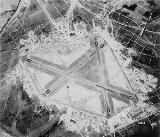
RAF Beaulieu
Encyclopedia
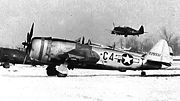
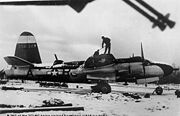
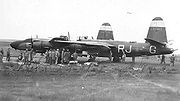
World War II
World War II, or the Second World War , was a global conflict lasting from 1939 to 1945, involving most of the world's nations—including all of the great powers—eventually forming two opposing military alliances: the Allies and the Axis...
airfield in the New Forest
New Forest
The New Forest is an area of southern England which includes the largest remaining tracts of unenclosed pasture land, heathland and forest in the heavily-populated south east of England. It covers south-west Hampshire and extends into south-east Wiltshire....
, Hampshire
Hampshire
Hampshire is a county on the southern coast of England in the United Kingdom. The county town of Hampshire is Winchester, a historic cathedral city that was once the capital of England. Hampshire is notable for housing the original birthplaces of the Royal Navy, British Army, and Royal Air Force...
, England
England
England is a country that is part of the United Kingdom. It shares land borders with Scotland to the north and Wales to the west; the Irish Sea is to the north west, the Celtic Sea to the south west, with the North Sea to the east and the English Channel to the south separating it from continental...
. It was also known as Beaulieu airfield, Beaulieu aerodrome and USAAF Station AAF 408. It is located approximately 2 miles (3.2 km) west of the village of Beaulieu
Beaulieu, Hampshire
Beaulieu is a small village located on the south eastern edge of the New Forest national park in Hampshire, England and home to both Palace House and the British National Motor Museum.- History :...
and 5 miles (8 km) east-northeast of Lymington
Lymington
Lymington is a port on the west bank of the Lymington River on the Solent, in the New Forest district of Hampshire, England. It is to the east of the South East Dorset conurbation, and faces Yarmouth on the Isle of Wight which is connected to it by a car ferry, operated by Wightlink. The town...
.
Opened on Saturday 8 August 1942, it was used by both the Royal Air Force
Royal Air Force
The Royal Air Force is the aerial warfare service branch of the British Armed Forces. Formed on 1 April 1918, it is the oldest independent air force in the world...
and then later United States Army Air Force. During the war it was used as a bomber and fighter airfield. After the war, it was used for experimental work before it was closed in 1959.
Today the remains of the airfield are on heathland managed by the Forestry Commission
Forestry Commission
The Forestry Commission is a non-ministerial government department responsible for forestry in Great Britain. Its mission is to protect and expand Britain's forests and woodlands and increase their value to society and the environment....
. Areas of the old airfield are now designated as a flying area for model aircraft.
Overview
An airfield at Beaulieu had been used as a landing ground as early as 1910 and was taken over by the military for flying training during the First World War. In the inter-war years, it was not considered suitable for enlargement to meet the requirements of the RAF during its expansion in the late 1930s. Nevertheless. with the fall of FranceBattle of France
In the Second World War, the Battle of France was the German invasion of France and the Low Countries, beginning on 10 May 1940, which ended the Phoney War. The battle consisted of two main operations. In the first, Fall Gelb , German armoured units pushed through the Ardennes, to cut off and...
in 1940 and the need for more airfields in the southern counties, the site was again reviewed but passed over in favour of a much more suitable area about 1 mile (1.6 km) to the west of the original aerodrome.
The new airfield opened as a Class A
Class A airfield
Class A airfields were military installations originally built for the Royal Air Force in the Second World War. Several were transferred to the U.S...
bomber airfield main feature of which was a set of three intersecting concrete runways placed at 60 degree angles to each other in a triangular pattern. Its runways included a main of 5900 feet (1,798.3 m) (10/28), 4100 feet (1,249.7 m) (04/22), and 4098 feet (1,249.1 m) (16/34). 50 "frying pan" hardstandings were constructed connecting to an enclosing perimeter track, of a standard width of 50 feet (15.2 m).
The station was constructed largely of Nissen hut
Nissen hut
A Nissen hut is a prefabricated steel structure made from a half-cylindrical skin of corrugated steel, a variant of which was used extensively during World War II.-Description:...
s of various sizes. This was where the group and ground station commanders, squadron headquarters and orderly rooms were located. Also on the ground station were where the mess facilities; chapel; hospital; mission briefing and debriefing; armoury and bomb dump; life support; parachute store; supply hut; station and airfield security; motor transport and the other ground support functions necessary to support the air operations of the group. These facilities were all connected by a network of single path support roads.
The technical site, connected to the ground station and northwest side of the airfield consisted of various organisational, component and field maintenance shops along with two T-2 type aircraft hangars, one at the site, the other on the south side of the airfield at a cluster of dispersal pads connected to the perimeter track. This is where the ground crew and other personnel necessary to keep the aircraft airworthy were located, whose mission was to repair the aircraft. Aircraft severely damaged in combat were dismantled and transported to depots for major structural repair. The ammunition dump was located outside of the perimeter track, surrounded by large dirt mounds and concrete storage pens for storage of bombs and ammunitions.
A number domestic accommodation sites were dispersed away from the airfield, within a mile or so of the technical support site, also using clusters of Maycrete or Nissen huts. These huts were either connected, set up end-to-end or built singly and made of prefabricated corrugated iron with a door and two small windows at the front and back. They provided accommodation for 2,197 servicemen, including communal facilities and a sick quarters.
RAF Bomber Command use
The pressing wartime need for additional airfields led to the re-evaluation of the site and the eventual development of airfield in 1942. As as soon as the runways and perimeter track were completed, an RAF Consolidated LiberatorB-24 Liberator
The Consolidated B-24 Liberator was an American heavy bomber, designed by Consolidated Aircraft of San Diego, California. It was known within the company as the Model 32, and a small number of early models were sold under the name LB-30, for Land Bomber...
squadron, No. 224. moved in, such was the critical situation with U-Boats in the Bay of Biscay
Bay of Biscay
The Bay of Biscay is a gulf of the northeast Atlantic Ocean located south of the Celtic Sea. It lies along the western coast of France from Brest south to the Spanish border, and the northern coast of Spain west to Cape Ortegal, and is named in English after the province of Biscay, in the Spanish...
.
Seven weeks after No 224 Squadron arrived, it was joined in its anti-submarine work by Handley Page Halifax
Handley Page Halifax
The Handley Page Halifax was one of the British front-line, four-engined heavy bombers of the Royal Air Force during the Second World War. A contemporary of the famous Avro Lancaster, the Halifax remained in service until the end of the war, performing a variety of duties in addition to bombing...
es of Bomber Command on loan to Coastal. Then, when the Halifax was withdrawn in March 1943, more Liberators arrived.
No 224 Squadron departed in April 1943, its place being taken by No 311 Squadron a Czech-manned unit, which was joined by No 53 Squadron in September 1943. Coastal Command left Beaulieu early in 1944 as the airfield was required for squadrons of the Second Tactical Air Force supporting the forthcoming invasion of the Continent
D-Day
D-Day is a term often used in military parlance to denote the day on which a combat attack or operation is to be initiated. "D-Day" often represents a variable, designating the day upon which some significant event will occur or has occurred; see Military designation of days and hours for similar...
.
RAF Hawker Typhoon
Hawker Typhoon
The Hawker Typhoon was a British single-seat fighter-bomber, produced by Hawker Aircraft. While the Typhoon was designed to be a medium-high altitude interceptor, and a direct replacement for the Hawker Hurricane, several design problems were encountered, and the Typhoon never completely satisfied...
squadrons then operated from the airfield although plans were already in hand to turn Beaulieu over to the USAAF.
USAAF use
Beaulieu was known as USAAF Station AAF 408 for security reasons by the USAAF during the war, and by which it was referred to instead of location. Its USAAF Station Code/Pundit Code was "BU".365th Fighter Group
From 1 March 1944 Beaulieu airfield was made available for USAAF Ninth Air ForceNinth Air Force
The Ninth Air Force is a numbered air force of the United States Air Force's Air Combat Command . It is headquartered at Shaw Air Force Base, South Carolina....
use. With the imminent arrival of more bomber groups in Essex the 365th Fighter Group
365th Fighter Group
The 365th Fighter Group is an inactive United States Army Air Force unit. Its last assignment was with the Army Service Forces stationed at Camp Myles Standish, Massachusetts. It was inactivated on 22 September 1945....
was transferred from RAF Gosfield
RAF Gosfield
RAF Station Gosfield is a former World War II airfield in Essex, England. The airfield is located approximately north of Braintree; about north-northeast of LondonOpened in 1943, it was used by both the Royal Air Force and United States Army Air Force...
on th 5 and 6 March 1944.
The 365th was a Republic P-47 Thunderbolt group, with the following operational squadrons:
- 386th Fighter Squadron386th Fighter SquadronThe 386th Fighter Squadron is an inactive United States Air Force unit. It was last assigned to the 365th Fighter Group, stationed at Camp Myles Standish, Massachusetts. It was inactivated on 22 September 1945-History:...
(D5) - 387th Fighter Squadron (B4)
- 388th Fighter Squadron (C4)
The 365th was a group of Ninth Air Force
Ninth Air Force
The Ninth Air Force is a numbered air force of the United States Air Force's Air Combat Command . It is headquartered at Shaw Air Force Base, South Carolina....
's 84th Fighter Wing
84th Fighter Wing (World War II)
The 84th Fighter Wing is an inactive United States Air Force unit. Its last assignment was with the IX Tactical Air Command, based at Brunswick, Germany...
, IX Tactical Air Command
IX Tactical Air Command
The IX Tactical Air Command is an inactive United States Air Force unit. Its last assignment was with the Ninth Air Force, based at Camp Shanks, New York...
.
The group was stood down three days after arrival so that it could undertake a two-week intensive course in ground attack and fighter-bombing. After training, the 365th flew dive-bombing missions to attack such targets as bridges, aerodromes, rail facilities, gun positions, and V-weapon sites prior to the invasion of the Continent.
On D-Day
D-Day
D-Day is a term often used in military parlance to denote the day on which a combat attack or operation is to be initiated. "D-Day" often represents a variable, designating the day upon which some significant event will occur or has occurred; see Military designation of days and hours for similar...
, its duties were attacking gun emplacements and communications facilities behind the bridgehead. Two P-47s were lost. On the following day, when 12 separate squadron-sized missions were flown, five aircraft failed to return.
On 9 June 1944 an unusual accident occurred. Two P-47s were being delivered to Beaulieu by ferry pilots, and they landed on different runways at the same time, colliding at the runway intersection. Unfortunately one of the pilots were killed.
The 365th was one of the most successful P-47 groups of the Ninth Air Force when it came to air combat, and a total of 29 enemy aircraft were credited as shot down during the four months the group operated from Beaulieu. On 25 June, the 365th had one of its best days when eight enemy fighter-bombers were destroyed. On 2 July, Lieutenant Colonel Robert Corey Junior, the Air Executive, became the Ninth Air Force's third Thunderbolt ace. As with other P-47 groups, losses were modest until June when ground attack became a regular task. All told, 24 P-47s were missing-in-action during their stay at Beaulieu.
The 365th Group began its move to Europe on 21 June 1944, the first squadron taking up residence at Azeville, France
France
The French Republic , The French Republic , The French Republic , (commonly known as France , is a unitary semi-presidential republic in Western Europe with several overseas territories and islands located on other continents and in the Indian, Pacific, and Atlantic oceans. Metropolitan France...
(A-71) on 26 June, the last moving out of Beaulieu on 28 June and the rear party on 2 July providing tactical air support in support of U.S. First Army.
323d Bombardment Group
Between 1 and 21 July the Martin B-26 MaraudersB-26 Marauder
The Martin B-26 Marauder was a World War II twin-engine medium bomber built by the Glenn L. Martin Company. First used in the Pacific Theater in early 1942, it was also used in the Mediterranean Theater and in Western Europe....
of the 323rd Bombardment Group arrived From RAF Earls Colne, a move designed to extend their range over western France
France
The French Republic , The French Republic , The French Republic , (commonly known as France , is a unitary semi-presidential republic in Western Europe with several overseas territories and islands located on other continents and in the Indian, Pacific, and Atlantic oceans. Metropolitan France...
. The group was assigned to the 3d Bombardment Wing
98th Bombardment Wing (World War II)
The 98th Bombardment Wing is an inactive United States Air Force unit. Its last assignment was with the United States Air Force Reserve, based at Bedford Field, Massachusetts...
with a Horizontal white tail band for its group marking. Operational squadrons of the 323d were:
- 453d Bombardment Squadron (VT)
- 454th Bombardment Squadron (RJ)
- 455th Bombardment Squadron (YU)
- 456th Bombardment Squadron456th Bombardment SquadronThe 456th Bombardment Squadron is an inactive United States Air Force unit. Its last was assigned to the 323d Bombardment Group, stationed at Tinker Air Force Base, Oklahoma. It was inactivated on 17 March 1951.-History:...
(WT)
Within a few days. over 60 B-26s were in residence and operations were well under way. During the following five weeks. 28 missions were flown from Beaulieu without loss, although one B-26 crash-landed near the airfield after running out of fuel.
Between the 16 and 26 of August the 323rd moved to Lessay
Lessay
Lessay is a commune in the Manche department in north-western France.-History:It was originally founded as a monastery but a town grew up around it over the years. The 10th century monastery is one of the greatest examples of Romanesque architecture in Normandy...
airfield in France
France
The French Republic , The French Republic , The French Republic , (commonly known as France , is a unitary semi-presidential republic in Western Europe with several overseas territories and islands located on other continents and in the Indian, Pacific, and Atlantic oceans. Metropolitan France...
(A-20), the main movement of aircraft taking place on the 26th August 1944.
Postwar military use
Following the move of the Americans to France, Beaulieu was then used as a staging or refuelling post for aircraft passing to and from Continental bases. Control was returned to the RAF in late September. At the time, Beaulieu was under consideration for enlargement as a heavy bomber airfield, although this came to nothing.In December 1944 the Airborne Forces Experimental Establishment (AFEE) moved to the airfield where it remained for nearly six years using a variety of aircraft. The AFEE was involved in experimental work with glider towing and parachute drops which used the old East Boldre Airfield site on the far side of the Lymington-Beaulieu road as a drop zone.
In September 1950 the AFEE moved out to RAF Boscombe Down and the airfield was without any flying units. Beaulieu was placed under Care and Maintenance status and was then declared inactive. On 1 April 1953 control passed once again to the United States Air Force
United States Air Force
The United States Air Force is the aerial warfare service branch of the United States Armed Forces and one of the American uniformed services. Initially part of the United States Army, the USAF was formed as a separate branch of the military on September 18, 1947 under the National Security Act of...
and the facility was upgraded, but in the event no further flying units arrived.
Finally, on 8 September 1955 Beaulieu airfield was handed back to the Air Ministry, in whose care it remained until November 1959 when they relinquished control of the land.
Civil use
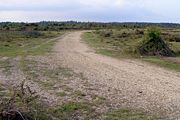
Crown land
In Commonwealth realms, Crown land is an area belonging to the monarch , the equivalent of an entailed estate that passed with the monarchy and could not be alienated from it....
s managed by the Forestry Commission. Half a century on from its use as a military airfield, the vast majority of the concreted areas of the airfield have been removed and returned to heathland, although the former locations of the runways along with the perimeter track are all clearly identifiable in aerial photography.
A small section of the eastern end of the 27/09 main runway near the Lymington road is still concreted and used as a runway, pit and pilot control area for model aircraft. The connecting length of the eastern perimeter road is used as a cycle track. No buildings around the airfield area exist although the old water tower still stands to the north west of the airfield on Roundhill campsite, a Forestry Commission site which uses part of the old access roads of the airfield. Small parts of the former airfield are now covered with conifers.
Model Flying
By means of permit to fly (currently £5 per annum), model aircraft are flown on a regular basis at this site. Provided acceptable weather, model pilots will be found every day at the site, Sunday mornings being particularly popular. There are separate flying areas set aside for radio controlled flight and free flight. Flyers are required to adhere to the Beaulieu Model Flying Committee rules and to those of the Forestry Commission.Directions
From LymingtonLymington
Lymington is a port on the west bank of the Lymington River on the Solent, in the New Forest district of Hampshire, England. It is to the east of the South East Dorset conurbation, and faces Yarmouth on the Isle of Wight which is connected to it by a car ferry, operated by Wightlink. The town...
, proceed northeast on the B3054 about 5 miles to the access road to the airfield campground on the left.

